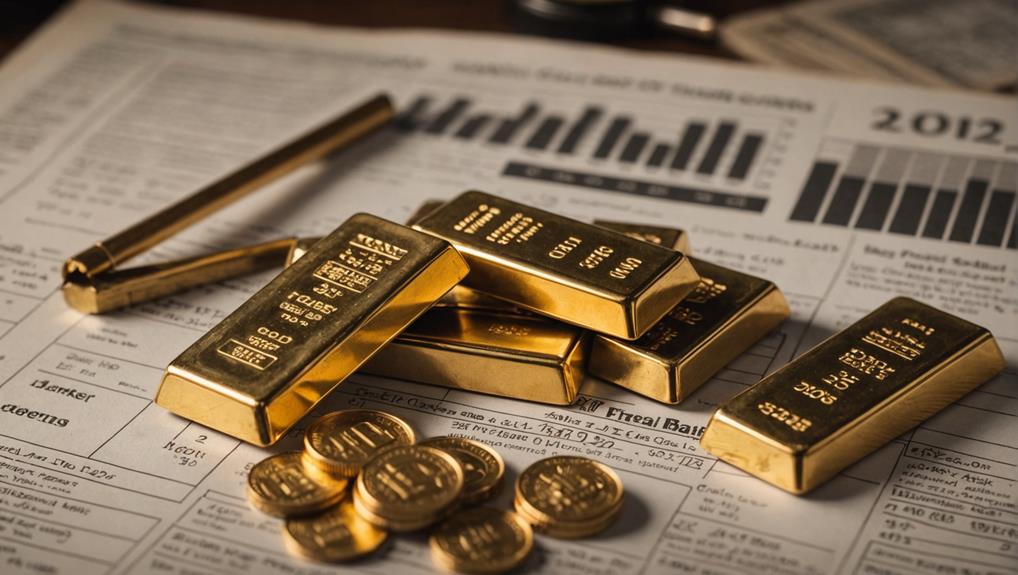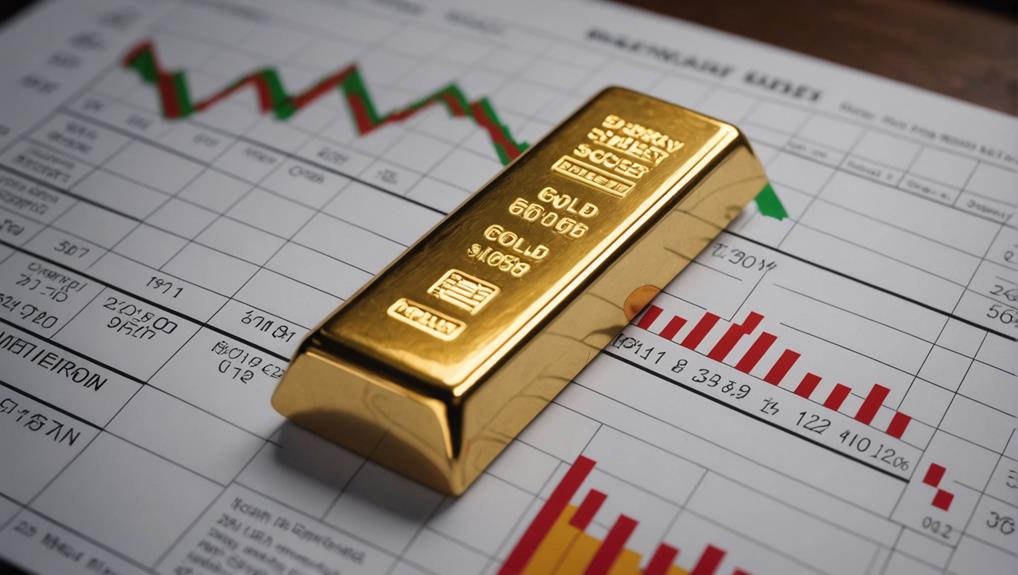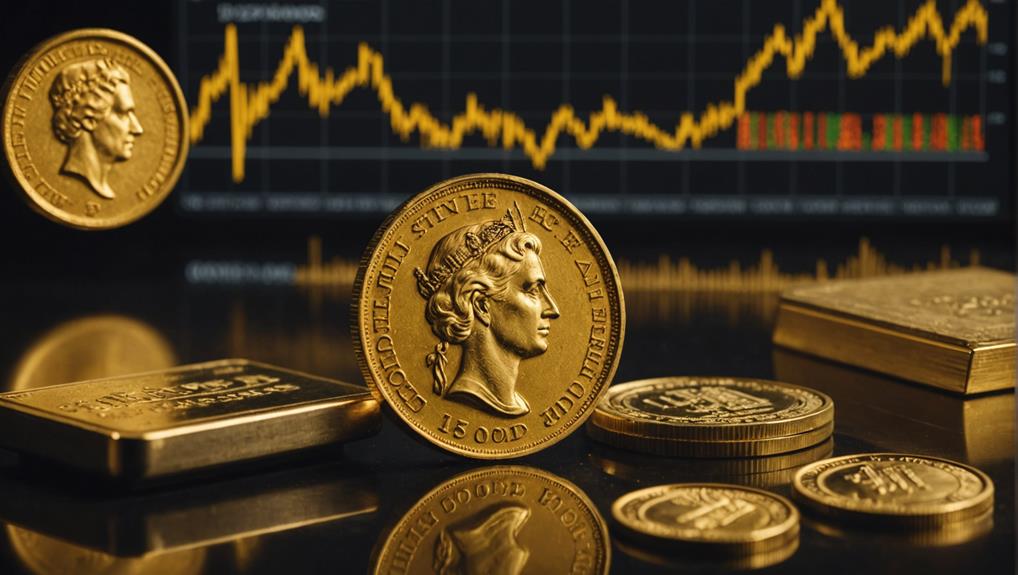Investing in gold during times of inflation has been a traditional method for safeguarding wealth. Historical data reveals a nuanced relationship between gold prices and inflation, demonstrating periods of strong correlation as well as divergence influenced by various economic and geopolitical factors.
While gold is commonly lauded as a reliable hedge against inflation, its performance can vary, necessitating careful consideration of market dynamics and the evolving role of gold in investment portfolios. This prompts investors to question the true efficacy of gold as an inflation hedge and the strategic adjustments needed for successful investment outcomes.
Key Insights
- Gold has historically averaged a 14.9% increase during high inflation years.
- Gold's connection with the money supply remains strong despite moderate CPI-based inflation.
- Gold's effectiveness as an inflation hedge varies with economic conditions and global events.
- Recent years (2021-2022) show subdued gold price growth despite rising inflation.
- Portfolio diversification with gold can mitigate risks during inflationary periods.
Gold's Performance in Inflationary Periods

Gold's performance during inflationary periods reveals a nuanced relationship shaped by various economic factors. Seen as an inflation hedge by central banks, gold's price trends historically exhibited an average increase of 14.9% during high inflation years from 1974 to 2008.
However, recent years like 2021 and 2022 have exposed gold's limitations as a short-term inflation hedge, with subdued price growth despite escalating inflation. The Consumer Price Index (CPI), a key inflation gauge, has demonstrated significant fluctuations in gold's value since 1972, highlighting the intricate interplay between gold prices and inflation, influenced by broader economic conditions and central bank policies.
Relationship Between Inflation and Gold Prices
To understand the relationship between inflation and gold prices, it is essential to explore the factors influencing gold's sensitivity to changes in the US Consumer Price Index (CPI).
Following the 1970s, gold prices have exhibited a diminished response to CPI fluctuations due to a relatively low inflationary environment. Despite this, historical data reveals a consistent correlation between gold prices and the growth of money supply.
This correlation implies that even though CPI-based inflation has remained moderate amidst central bank balance sheet expansions, gold continues to exhibit a strong connection with the money supply.
Therefore, a comprehensive analysis of gold price movements necessitates considering variables beyond CPI, such as monetary policy and central bank interventions, to grasp the full scope of its behavior in the context of inflation.
Effectiveness of Gold as an Inflation Hedge

Gold's reliability as an inflation hedge is a topic of debate, given its inconsistent short-term performance and susceptibility to external influences. While historically gold has demonstrated varying effectiveness in safeguarding against inflation, its value can be volatile in the short term due to factors like supply, demand, and market dynamics.
Looking at the long term, gold does exhibit potential as an inflation hedge; however, its performance is subject to the ebb and flow of economic conditions and global geopolitical events. The complex relationship between gold prices and inflation rates over 10-year periods suggests that relying solely on gold for inflation protection may not be straightforward.
Investors should carefully consider these factors and exercise caution when using gold as a hedge against inflation.
Gold's Role in Portfolio Diversification
Gold plays a crucial role in portfolio diversification due to its historical performance and unique attributes. Its value as a hedge against inflation and economic uncertainties has been well-established. During times of inflation, gold tends to appreciate, providing a valuable safeguard for investors. Moreover, its reputation as a safe haven asset shines through in times of economic turmoil, offering stability when traditional assets falter.
Comparing Gold to Other Inflation Hedges

To assess gold as an inflation hedge effectively, it is essential to compare it with other assets such as stocks, real estate, and commodities. This comparison helps in understanding how gold performs relative to these assets during periods of inflation.
While gold bullion delivered a remarkable 35% annual return in the 1970s, its performance has exhibited inconsistency over time. On the other hand, stock market indices like the S&P 500 have consistently outperformed inflation, offering investors stability and long-term growth potential. Real estate has also demonstrated strong performance, often surpassing the returns generated by gold.
Commodities, including gold, are recognized as reliable hedges against inflation, despite their inherent volatility. However, when considering gold's value relative to the Consumer Price Index (CPI) since 1972, its effectiveness as a short-term hedge has fluctuated. This fluctuation underscores the importance of diversifying one's portfolio with a mix of assets to mitigate risks associated with inflation.
While gold remains a valuable asset with historical significance, its effectiveness as an inflation hedge may vary when compared to other investment options.
Factors Influencing Gold Prices
Economic uncertainty often drives investors towards gold as a safe-haven asset, leading to increased demand and higher prices.
Moreover, the supply and demand dynamics, influenced by mining outputs and consumer behavior, play a vital role in determining gold prices.
Understanding these factors is necessary for investors seeking to manage the intricacies of gold investments during inflationary periods.
Economic Uncertainty Impact
Gold becomes an attractive investment option during times of economic uncertainty due to various factors. Currency devaluation prompts investors to turn to gold as a safe haven asset. Geopolitical tensions contribute to higher gold prices as investors seek stability in turbulent times.
Lower interest rates make gold more appealing compared to other investments, as it is seen as a reliable store of value. Additionally, increased market volatility boosts the attractiveness of gold as a secure investment choice.
Supply and Demand Dynamics
To grasp the dynamics of gold supply and demand is crucial since these factors wield significant influence over its pricing and investment attractiveness, especially in times of economic uncertainty. The production levels of gold, encompassing both mine output and recycling endeavors, directly shape the available supply.
Concurrently, the policies of central banks, involving the sale and acquisition of gold reserves, play a pivotal role in the market.
On the demand side, economic instabilities and geopolitical tensions serve as catalysts for investor interest in gold as a safe-haven asset. Additionally, demand stemming from sectors like jewelry and technology also exerts influence on prices.
The delicate equilibrium between these supply and demand factors, in tandem with broader economic indicators such as inflation rates and currency fluctuations, ultimately dictates the prevailing market price of gold.
Evolution of Gold as a Store of Value

Gold's role as a store of value has deep historical roots, dating back to ancient civilizations like Egypt and Rome, who prized it for its scarcity and inherent worth.
The adoption of the gold standard in the 19th and early 20th centuries further cemented gold's reputation as a reliable means of preserving wealth.
Even as economies moved away from the gold standard, gold adapted, serving as a bulwark against economic uncertainty and a hedge against inflation.
In contemporary investment strategies, gold remains highly sought after as a portfolio diversifier, offering stability in the face of market fluctuations.
Risks and Considerations in Gold Investing
Investing in gold carries intrinsic risks and requires careful consideration of market dynamics. Volatility and market fluctuations can significantly impact the value of gold, influenced by speculative trading and regulatory changes.
Moreover, while broadening a portfolio with gold may reduce overall risk, investors must stay watchful about currency fluctuations and thoroughly understand the market to avoid potential losses.
Volatility and Market Fluctuations
Gold investment is influenced by its inherent volatility, which can result in significant price fluctuations driven by factors beyond just inflation. Market dynamics play a crucial role in shaping gold prices, leading to short-term unpredictability and potential financial risks for investors. It is imperative to comprehend and effectively manage these investment risks, given that gold's value can be swayed by speculation, geopolitical uncertainties, and macroeconomic conditions. These elements, alongside inflationary pressures, contribute to the complex nature of gold investments.
Geopolitical events, such as conflicts and political instability, have the potential to trigger abrupt changes in gold prices. Additionally, investor behavior and market sentiments play a pivotal role in driving volatility in the gold market. Moreover, macroeconomic factors like interest rates, currency fluctuations, and economic indicators can exert influence on the price of gold.
In times of inflation, the interplay of these factors can heighten the intrinsic volatility of gold investments and pose challenges for investors seeking to navigate market fluctuations effectively.
Diversification and Risk Management
In the context of rising inflation, diversifying a portfolio by including gold can be a prudent risk management strategy to enhance stability. Gold investments historically exhibit a low correlation with other assets during inflationary periods, thereby reducing overall portfolio risk.
However, investors need to be mindful of potential risks such as market volatility, regulatory changes, and currency fluctuations. Implementing effective risk management tactics, such as utilizing stop-loss orders, is essential in navigating these uncertainties. Additionally, factors like storage costs, transaction fees, and liquidity should be carefully evaluated to optimize risk management practices.
When it comes to market volatility, which can be significant, employing stop-loss orders can help mitigate potential losses. Regulatory changes, while having a moderate impact, necessitate staying informed and adapting investment strategies accordingly. On the other hand, the impact of storage costs on gold investment is relatively low, but it's crucial to assess various storage options to minimize expenses.
Given gold's historical stability and ability to retain value, integrating it into a portfolio can serve as a valuable diversification tool to counter the effects of inflation.
Conclusion
To sum up, investing in gold during inflationary periods has shown varied effectiveness as a hedge against rising prices. The historical connection between inflation and gold prices has been impacted by various economic and geopolitical factors.
While gold can have a significant impact on portfolio diversification, it is fundamental for investors to consider a mix of assets to manage risks effectively. Careful assessment of market conditions and a comprehensive understanding of factors influencing gold prices are vital for informed investment decisions.
For more information and resources on gold investing, please visit:
The Gold Information Network
11900 Biscayne Blvd, Ste 127B, Miami, FL 33181
(305) 449-9094
https://goldinfo.net







